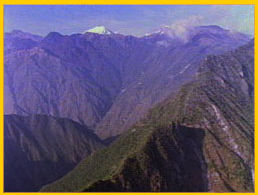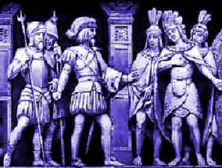
Overview
"Land of the Four Quarters" or Tahuantinsuyu is the name the Inca gave
to their empire.
The Inca state's domain was unprecedented, its rule resulting in a universal language - a form of Quechua, a religion worshipping the sun, and a 14,000 mile-long road system criss-crossing high Andean mountain passes and linking the rulers with the ruled. The Incan empire, at the period of the Spanish invasion, stretched along the Pacific from about the second degree north to the thirty-seventh degree of south latitude; a line, also, which describes the western boundaries of the modern republics of Ecuador, Peru, Bolivia, and Chili. Quite an astoundingly large empire of which the topographical aspect of the country is also quite remarkable. A strip of land, rarely exceeding twenty leagues in width, runs along the coast, and is hemmed in through its whole extent by a colossal range of mountains. The source of this civilization is traced to the valley of Cuzco, the central region of Peru. Those who headed the Inca state were known by various titles, including "Sapa Inca," "Capac Apu," and "Intip Cori." Often, an emperor was simply referred to as "the Inca." Rather than having a crown, the Inca emperors wore a fringe on the center of their headdress as a symbol of their status. It is important to note that the term "Inca" can refer not only to the ruler, but also to people belonging to the ethnic group that settled in the Cuzco region at the time of Manco Capac; these people were all Incas by birth. Other people, mainly groups in the regions surrounding Cuzco, were given the honorary status of "Incas by privilege." In contrast, people native to the other regions conquered and controlled by the Incas belonged to many other ethnic groups, such as the Chachapoyas, Cañaris, and Wankas. These people were not considered Incas.
Because they had no written language, what we know of the history of
the Incas and their realm comes from chronicles and other documents written
in the decades after the Spanish conquest. The stories in those chronicles
had been passed down orally over the generations, and were collected in
different parts of the empire over many years. Add the biases of
those retelling and recording the tales to the variations induced by time
and space, and we are confronted with many different versions  of
stories about the founding of Cuzco, the names and deeds
of Inca emperors, the expansion of Inca power, etc. It is no surprise that
these stories often seem to contradict each other. Moreover, many of these
stories are ultimately derived from the Incas' own "official" version of
history, which was probably to a great extent fabricated to glorify the
emperors and their heritage. The Inca propaganda did little
to preserve the history of cultures prior to the Inca empire, and in fact
rarely acknowledged that they existed. So in the end, by reconstructing
Inca history from Spanish written sources, we are not coming up with a
representation of events as they actually occurred, but instead we arrive
at what is hopefully a reasonable approximation of Inca history as sanctioned
by the Inca state.
of
stories about the founding of Cuzco, the names and deeds
of Inca emperors, the expansion of Inca power, etc. It is no surprise that
these stories often seem to contradict each other. Moreover, many of these
stories are ultimately derived from the Incas' own "official" version of
history, which was probably to a great extent fabricated to glorify the
emperors and their heritage. The Inca propaganda did little
to preserve the history of cultures prior to the Inca empire, and in fact
rarely acknowledged that they existed. So in the end, by reconstructing
Inca history from Spanish written sources, we are not coming up with a
representation of events as they actually occurred, but instead we arrive
at what is hopefully a reasonable approximation of Inca history as sanctioned
by the Inca state.
Here at this site we hope to illustrate some of what we know about Incan
religion through these chronicles and other archaeological findings.
In particular we want to elucidate what is known about Incan Cosmology,
Rituals,
and Deities.
Works Consulted: The Peru Reader, and History of the Inca Realm.
Picture Credits: Landscape: http://raingod.com/angus/Gallery/Photos/SouthAmerica/Peru/IncaTrail/Index.html
Spanish Soldiers: http://emuseum.mankato.msus.edu/prehistory/latinamerica/topics/spanish_conquest.html